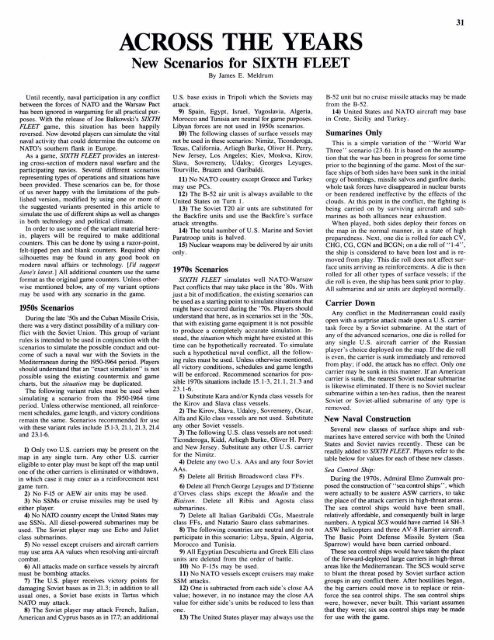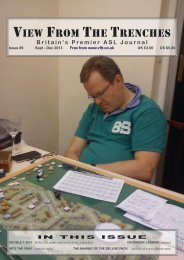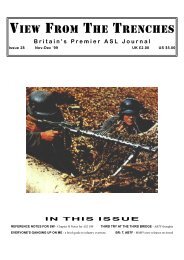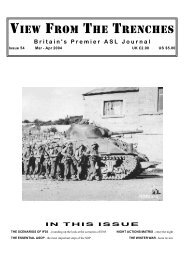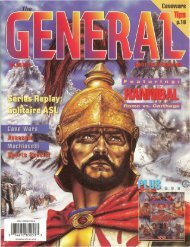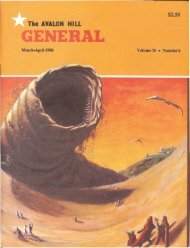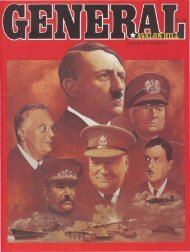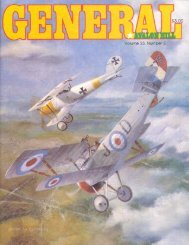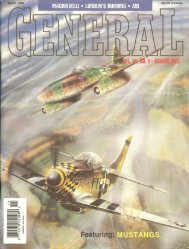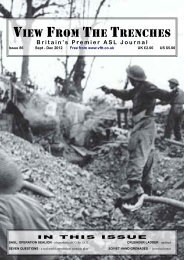Create successful ePaper yourself
Turn your PDF publications into a flip-book with our unique Google optimized e-Paper software.
Until recently, naval participation in any conflict<br />
between the forces of NATO and the Warsaw Pact<br />
has been ignored in wargaming for all practical pur-<br />
poses. With the release of Joe Balkowski's SIXTH<br />
FLEET game, this situation has been happily<br />
reversed. <strong>No</strong>w devoted players can simulate the vital<br />
naval activity that could determine the outcome on<br />
NATO's southern flank in Europe.<br />
As a game, SIXTH FLEET provides an interest-<br />
ing cross-section of modern naval warfare and the<br />
participating navies. Several different scenarios<br />
representing types of operations and situations have<br />
been provided. <strong>The</strong>se scenarios can be, for those<br />
of us never happy with the limitations of the pub-<br />
lished version, modified by using one or more of<br />
the suggested variants presented in this article to<br />
simulate the use of different ships as well as changes<br />
in both technology and political climate.<br />
In order to use some of the variant material here-<br />
in, players will be required to make additional<br />
counters. This can be done by using a razor-point,<br />
felt-tipped pen and blank counters. Required ship<br />
silhouettes may be found in any good book on<br />
modern naval affairs or technology. [I'd suggest<br />
Jane's latest.] All additional counters use the same<br />
format as the original game counters. Unless other-<br />
wise mentioned below, any of my variant options<br />
may be used with any scenario in the game.<br />
1950s Scenarios<br />
During the late '50s and the Cuban Missile Crisis,<br />
there was a very distinct possibility of a military con-<br />
flict with the Soviet Union. This group of variant<br />
rules is intended to be used in conjunction with the<br />
scenarios to simulate the possible conduct and out-<br />
come of such a naval war with the Soviets in the<br />
Mediterranean during the 1950-1964 period. Players<br />
should understand that an "exact simulation" is not<br />
possible using the existing countennix and game<br />
charts, but the situation may be duplicated.<br />
<strong>The</strong> following variant rules must be used when<br />
simulating a scenario from the 1950-1964 time<br />
period. Unless otherwise mentioned, all reinforce-<br />
ment schedules, game length, and victory conditions<br />
remain the same. Scenarios recommended for use<br />
with these variant rules include 15.1-3, 21.1, 21.3, 21.4<br />
and 23.1-6.<br />
1) Only two U.S. carriers may be present on the<br />
map in any single turn. Any other U.S. carrier<br />
eligible to enter play must be kept off the map until<br />
one of the other carriers is eliminated or withdrawn,<br />
in which case it may enter as a reinforcement next<br />
game turn.<br />
2) <strong>No</strong> F-15 or AEW air units may be used.<br />
3) <strong>No</strong> SSMs or cruise missiles may be used by<br />
either player.<br />
4) <strong>No</strong> NATO country except the United States may<br />
use SSNs. All diesel-powered submarines may be<br />
used. <strong>The</strong> Soviet player may use Echo and Juliet<br />
class submarines.<br />
5) <strong>No</strong> vessel except cruisers and aircraft carriers<br />
may use area AA values when resolving anti-aircraft<br />
combat.<br />
6) All attacks made on surface vessels by aircraft<br />
must be bombing attacks.<br />
7) <strong>The</strong> U.S. player receives victory points for<br />
damaging Soviet bases as in 21.3; in addition to all<br />
usual ones, a Soviet base exists in Tartus which<br />
NATO may attack.<br />
8) <strong>The</strong> Soviet player may attack French, Italian,<br />
American and Cyprus bases as in 17.7; an additional<br />
ACROSS THE YEARS<br />
New Scenarios for SIXTH FLEET<br />
By James E. Meldrum<br />
U.S. base exists in Tripoli which the Soviets may<br />
attack.<br />
9) Spain, Egypt, Israel, Yugoslavia, Algeria,<br />
Morocco and lbnisia are neutral for game purposes.<br />
Libyan forces are not used in 1950s scenarios.<br />
10) <strong>The</strong> following classes of surface vessels may<br />
not be used in these scenarios: Nimitz, Ticonderoga,<br />
Texas, California, Arliegh Burke, Oliver H. Perry,<br />
New Jersey, Los Angeles; Kiev, Moskva, Kirov,<br />
Slava, Sovremeny, Udaloy; Georges Leyuges,<br />
Tourville, Brazen and Garibaldi.<br />
11) <strong>No</strong> NATO country except Greece and Turkey<br />
may use PCs.<br />
12) <strong>The</strong> B-52 air unit is always available to the<br />
United States on Turn 1.<br />
13) <strong>The</strong> Soviet T20 air unts are substituted for<br />
the Backfire units and use the Backfire's surface<br />
attack strengths.<br />
14) <strong>The</strong> total number of U.S. Marine and Soviet<br />
Paratroop units is halved.<br />
15) Nuclear weapons may be delivered by air units<br />
only.<br />
1970s Scenarios<br />
SIXTH FLEET simulates well NATO-Warsaw<br />
Pact conflicts that may take place in the '80s. With<br />
just a bit of modification, the existing scenarios can<br />
be used as a starting pint to simulate situations that<br />
might have occurred during the '70s. Players should<br />
understand that here, as in scenarios set in the '50s,<br />
that with existing game equipment it is not possible<br />
to produce a completely accurate simulation. In-<br />
stead, the situation which might have existed at this<br />
time can be hypothetically recreated. To simulate<br />
such a hypothetical naval conflict, all the follow-<br />
ing rules must be used. Unless otherwise mentioned,<br />
all victory conditions, schedules and game lengths<br />
will be enforced. Recommend scenarios for pos-<br />
sible 1970s situations include 15.1-3, 21.1, 2 1.3 and<br />
23.1-6.<br />
1) Substitute Kara and/or Kynda class vessels for<br />
the Kirov and Slava class vessels.<br />
2) <strong>The</strong> Kirov, Slava, Udaloy, Sovremeny, Oscar,<br />
Alfa and Kilo class vessels are not used. Substitute<br />
any other Soviet vessels.<br />
3) <strong>The</strong> following U.S. class vessels are not used:<br />
Ticonderoga, Kidd, Arliegh Burke, Oliver H. Peny<br />
and New Jersey. Substitute any other U.S. carrier<br />
for the Nimitz.<br />
4) Delete any two U.S. AAs and any four Soviet<br />
AAs.<br />
5) Delete all British Broadsword class FFs.<br />
6) Delete all French George Leyuges and D'Estienne<br />
d'Orves class ships except the Moulin and the<br />
Blaison. Delete all Ribis and Agosta class<br />
submarines.<br />
7) Delete all Italian Garibaldi CGs, Maestrale<br />
class FFs, and Natario Sauro class submarines.<br />
8) <strong>The</strong> following countries are neutral and do not<br />
participate in this scenario: Libya, Spain, Algeria,<br />
Morocco and Tunisia.<br />
9) All Egyptian Descubierta and Greek Elli class<br />
units are deleted from the order of battle.<br />
10) <strong>No</strong> F-15s may be used.<br />
11) <strong>No</strong> NATO vessels except cruisers may make<br />
SSM attacks.<br />
12) One is subtracted from each side's close AA<br />
value; however, in no instance may the close AA<br />
value for either side's units be reduced to less than<br />
one.<br />
13) <strong>The</strong> United States player may always use the<br />
B-52 unit but no cruise missile attacks may be made<br />
from the B-52.<br />
14) United States and NATO aircraft may base<br />
in Crete, Siciliy and Turkey.<br />
Sumarines Only<br />
This is a simple variation of the "World War<br />
Three" scenario (23.6). It is based on the assump-<br />
tion that the war has been in progress for some time<br />
prior to the beginning of the game. Most of the sur-<br />
face ships of both sides have been sunk in the initial<br />
orgy of bombings, missile salvos and gunfire duels;<br />
whole task forces have disappeared in nuclear bursts<br />
or been rendered ineffective by the effects of the<br />
clouds. At this point in the conflict, the fighting is<br />
being carried on by surviving aircraft and sub-<br />
marines as both alliances near exhaustion.<br />
When played, both sides deploy their forces on<br />
the map in the normal manner, in a state of high<br />
preparedness. Next, one die is rolled for each CV,<br />
CHG, CG, CGN and BCGN; on a die roll of " 14",<br />
the ship is considered to have been lost and is re-<br />
moved from play. This die roll does not affect sur-<br />
face units arriving as reinforcements. A die is then<br />
rolled for all other types of surface vessels; if the<br />
die roll is even, the ship has been sunk prior to play.<br />
All submarine and air units are deployed normally.<br />
Carrier Down<br />
Any conflict in the Mediterranean could easily<br />
open with a surprise attack made upon a U.S. carrier<br />
task force by a Soviet submarine. At the start of<br />
any of the advanced scenarios, one die is rolled for<br />
any single U.S. aircraft carrier of the Russian<br />
player's choice deployed on the map. If the die roll<br />
is even, the carrier is sunk immediately and removed<br />
from play; if odd, the attack has no effect. Only one<br />
carrier may be sunk in this manner. If an American<br />
carrier is sunk, the nearest Soviet nuclear submarine<br />
is likewise eliminated. If there is no Soviet nuclear<br />
submarine within a ten-hex radius, then the nearest<br />
Soviet or Soviet-allied submarine of any type is<br />
removed.<br />
New Naval Construction<br />
Several new classes of surface ships and submarines<br />
have entered service with both the United<br />
States and Soviet navies recently. <strong>The</strong>se can be<br />
readily added to SIXTH FLEET. Players refer to the<br />
table below for values for each of these new classes.<br />
Sea Control Ship:<br />
During the 1970s, Admiral Elmo Zumwalt proposed<br />
the conseuction of "sea control ships", which<br />
were actually to be austere ASW carriers, to take<br />
the place of the attack carriers in high-threat areas.<br />
<strong>The</strong> sea control ships would have been small,<br />
relatively affordable, and consequently built in large<br />
numbers. A typical SCS would have canied 14 SH-3<br />
ASW helicopters and three AV-8 Harrier aircraft.<br />
<strong>The</strong> Basic Point Defense Missile System (Sea<br />
Sparrow) would have been carried onboard.<br />
<strong>The</strong>se sea control ships would have taken the place<br />
of the forward-deployed large carriers in high-threat<br />
areas like the Mediterranean. <strong>The</strong> SCS would serve<br />
to blunt the threat posed by Soviet surface action<br />
groups in any conflict there. After hostilities began,<br />
the big carriers could move in to replace or reinforce<br />
the sea control ships. <strong>The</strong> sea control ships<br />
were, however, never built. This variant assumes<br />
that they were; six sea control ships may be made<br />
for use with the game.


